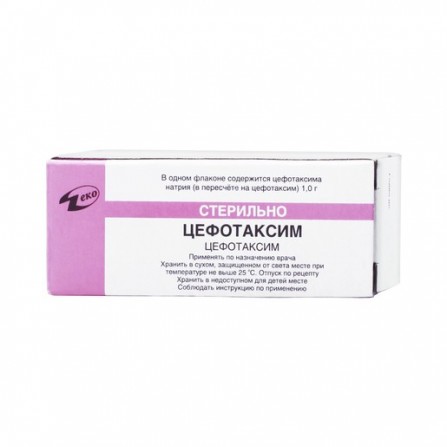Cefotaxime powder for injection vial 1g N1
Condition: New product
1000 Items
Rating:
Be the first to write a review!

More info
Active ingredients
Cefotaxime
Release form
Powder
Composition
Contains in 1 vial: Cefotaxime 1000 mg
Pharmacological effect
Cephalosporin antibiotic III generation broad-spectrum. It has a bactericidal effect by inhibiting the synthesis of the bacterial cell wall. The mechanism of action is due to the acetylation of membrane-bound transpeptidases and the disruption of peptidoglycans cross-linking necessary for ensuring the strength and rigidity of the cell wall. ., Serratia spp., Some strains of Pseudomonas spp., Haemophilus influenzae. Less active against Streptococcus spp. (including Streptococcus pneumoniae), Staphylococcus spp., Neisseria meningitidis, Neisseria gonorrhoeae, Bacteroides spp. Resistant to most β-lactamase.
Pharmacokinetics
Rapidly absorbed from the injection site. Plasma protein binding is 40%. Widely distributed in tissues and body fluids. Reaches therapeutic concentrations in the cerebrospinal fluid, especially in meningitis. Penetrates through the placental barrier, excreted in breast milk in low concentrations. Partially metabolized in the liver. 40-60% of the dose is excreted in the urine unchanged after 24 hours, 20% in the form of metabolites.
Indications
Infectious and inflammatory diseases caused by susceptible microorganisms, including: - CNS infections (meningitis); infections of the respiratory tract and upper respiratory tract; infections of the urinary tract; infections of bones and joints; infections of the skin and soft tissues; infections of the pelvic organs; - abdominal infections; - peritonitis; - sepsis; - endocarditis; - gonorrhea; - infected wounds and burns; - salmonellosis; - Lyme disease; - infections in the background of immunodeficiency.Prevention of infections after surgery (including urological, obstetric and gynecological, and gastrointestinal tract).
Contraindications
- pregnancy; - children's age up to 2.5 years (for intramuscular administration); - hypersensitivity (including to penicillins, other cephalosporins, carbapenems).
Precautionary measures
With caution prescribed for chronic renal failure.
Use during pregnancy and lactation
The use of cefotaxime in the first trimester of pregnancy is not recommended. Use in the second and third trimesters of pregnancy and lactation is possible only in cases where the intended benefit to the mother outweighs the potential risk to the fetus or infant. It should be borne in mindthat after iv administration of cefotaxime at a dose of 1 g in 2-3 hours, the maximum concentration of the active substance in breast milk is on average 0.32 ± 0.09 mcg / ml. At such a concentration, a negative effect on the oropharyngeal flora of a child is possible. In experimental animal studies, no teratogenic and embryotoxic effects of cefotaxime were found.
Dosage and administration
Set individually, taking into account the severity of the course and localization of the infection, the sensitivity of the pathogen. Enter in / m or / in (jet or drip). The average daily dose for adults is 1 g, the frequency of administration is 2-4 times / day. For the prevention of postoperative infection, it is administered in a dose of 1 g 30 minutes before surgery, 0.5-1 g during surgery and 0.5-1 g every 6- 8 hours a day after surgery. Maximum dose: 6 g / day. For children, the average daily dose is 20-40 mg / kg; in case of severe infections, the dose may be increased to 100 mg / kg / day. The duration of treatment is 7-10 days.
Side effects
From the side of the central nervous system: headache, dizziness. From the urinary system: renal dysfunction, oliguria, interstitial nephritis. From the digestive system: nausea, vomiting, diarrhea or constipation, flatulence, abdominal pain, dysbacteriosis, abnormal liver function; rarely - stomatitis, glossitis, pseudomembranous enterocolitis, increased activity of hepatic transaminases and alkaline paraphysic traps, agmyl., hyperbilirubinemia. rapid bolus injection into the central vein. Laboratory parameters: azotemia, increased urea concentration in the blood, hypercreatininemia, Coombs positive reaction. Place Noe reactions: phlebitis, soreness along the veins, soreness and infiltration at the site of the injection. Allergic reactions: urticaria, chills or fever, rash, pruritus; rarely - bronchospasm, eosinophilia, malignant exudative erythema (Stevens-Johnson syndrome), toxic epidermal necrolysis (Lyell's syndrome), angioedema, anaphylactic shock. Others: superinfection (vaginal and oral candidiasis).
Overdose
Symptoms: increased neuromuscular excitability, convulsions, tremor, encephalopathy (especially in patients with renal failure). Treatment: symptomatic, maintenance of vital functions. The specific antidote is absent.
Interaction with other drugs
Cefotaxime, inhibiting the intestinal flora, interferes with the synthesis of vitamin K. Therefore, when used simultaneously with drugs that reduce platelet aggregation (NSAIDs, salicylates, sulfinpirazon), the risk of bleeding increases. For the same reason, with simultaneous use with anticoagulants, there is an increase in anticoagulant action. When used simultaneously with aminoglycosides, polymyxin B and loop diuretics, the risk of kidney damage increases. When used simultaneously with drugs that reduce tubular secretion, the concentration of cefotaxime in the blood plasma rises. cefotaxime by reducing the tubular secretion of the latter.
special instructions
Cefotaxime is used with caution in cases of impaired renal function, indications of a history of colitis, and also in newborns. In patients with hypersensitivity to penicillins, allergic reactions to cephalosporin antibiotics are possible. During the period of treatment, a positive direct Coombs reaction and a false positive reaction of urine to glucose are possible. Following use with caution simultaneously with loop diuretics.



